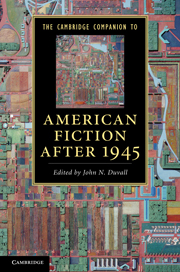Book contents
- Frontmatter
- Introduction: A story of the stories of American fiction after 1945
- PART I POETICS AND GENRES
- PART II HISTORICAL AND CULTURAL CONTEXTS
- PART III MAJOR AUTHORS
- 14 Ralph Ellison
- 15 Flannery O'Connor
- 16 Thomas Pynchon
- 17 Toni Morrison
- 18 Don DeLillo
- Conclusion: Whither American fiction?
- Index
- Cambridge Companions to …
17 - Toni Morrison
from PART III - MAJOR AUTHORS
Published online by Cambridge University Press: 28 March 2012
- Frontmatter
- Introduction: A story of the stories of American fiction after 1945
- PART I POETICS AND GENRES
- PART II HISTORICAL AND CULTURAL CONTEXTS
- PART III MAJOR AUTHORS
- 14 Ralph Ellison
- 15 Flannery O'Connor
- 16 Thomas Pynchon
- 17 Toni Morrison
- 18 Don DeLillo
- Conclusion: Whither American fiction?
- Index
- Cambridge Companions to …
Summary
Born in Lorain, Ohio, in 1931, Toni Morrison was awarded the Nobel Prize for Literature in 1993, the first African American woman to be so honored. A major focus of her work is the reinterpretation of key events and periods in African American women's history. Within this framework, her fiction explores themes such as race, gender, redemption, reconciliation, forgiveness, love, and desire. To date, she is the author of nine novels, including one of the most significant trilogies in modern American literature.
Morrison's trilogy, consisting of Beloved (1987), Jazz (1992), and Paradise (1997), spans 150 years of African American history. While the conventional historical saga usually charts a sequential narrative through generations of the same family, Morrison's trilogy consists of three very different novels, each located in an important period in black history. In its scope and form, Beloved is generally regarded as her most ambitious refocusing of history, in this case an exploration of slavery in nineteenth-century America from a black woman's perspective. But to fully understand this aspect of Morrison's work, it is important to recognize the way in which her novels juxtapose events from different periods of history and weave literary and historical allusions, myths, fables, and cultural anecdotes together.
- Type
- Chapter
- Information
- The Cambridge Companion to American Fiction after 1945 , pp. 233 - 243Publisher: Cambridge University PressPrint publication year: 2011

